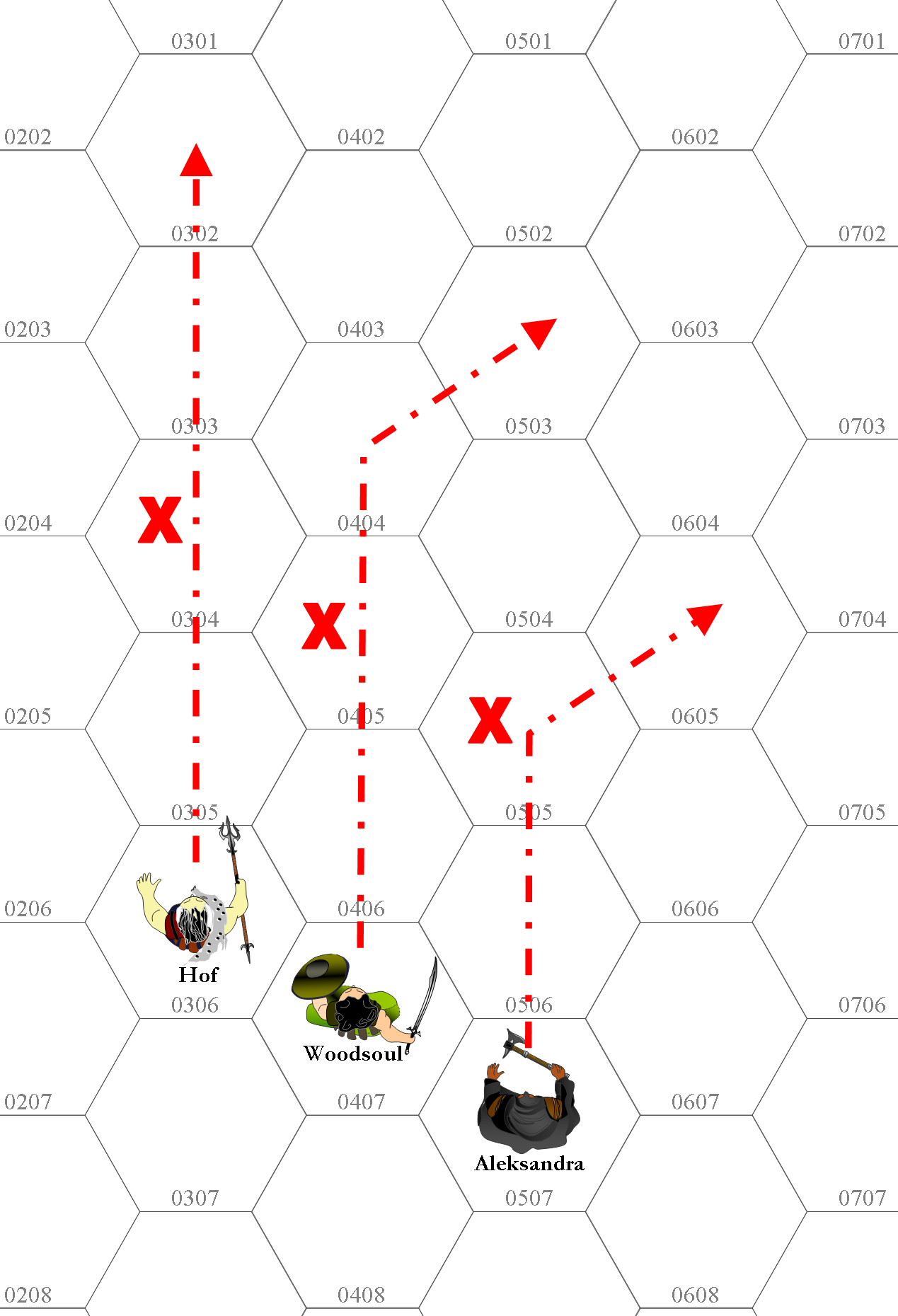Difference between revisions of "Movement (stride)"
Tao alexis (talk | contribs) |
Tao alexis (talk | contribs) |
||
| Line 14: | Line 14: | ||
| Sprinting || 6-8 | | Sprinting || 6-8 | ||
|} | |} | ||
| − | + | __TOC__ | |
There are four general categories of "stride:" wary, walking, running and sprinting. A range of AP cost is shown for each on the left-hand table. For example, if a combatant wants to "walk," then he or she chooses to do so at a stride-2 or a stride-3. Both are counted as "running" for game purposes. In terms of distance, it means that a combatant with 4 AP could set off at walking speed, moving either 2 or 3 hexes per action point spent — thus covering a distance of 8 to 12 hexes, whatever the combatant desired. | There are four general categories of "stride:" wary, walking, running and sprinting. A range of AP cost is shown for each on the left-hand table. For example, if a combatant wants to "walk," then he or she chooses to do so at a stride-2 or a stride-3. Both are counted as "running" for game purposes. In terms of distance, it means that a combatant with 4 AP could set off at walking speed, moving either 2 or 3 hexes per action point spent — thus covering a distance of 8 to 12 hexes, whatever the combatant desired. | ||
Revision as of 00:51, 11 October 2023
Movement pertains to the action point (AP) cost associated with travelling from one combat hex to another, with each hex measuring 5 feet in diameter. The combatant's ability to cover distance within a combat round depends upon the character's "stride," which is the number of hexes that are bought with per AP.
| Stride | Hexes/AP |
|---|---|
| Wary | 1 |
| Walking | 2-3 |
| Running | 4-5 |
| Sprinting | 6-8 |
There are four general categories of "stride:" wary, walking, running and sprinting. A range of AP cost is shown for each on the left-hand table. For example, if a combatant wants to "walk," then he or she chooses to do so at a stride-2 or a stride-3. Both are counted as "running" for game purposes. In terms of distance, it means that a combatant with 4 AP could set off at walking speed, moving either 2 or 3 hexes per action point spent — thus covering a distance of 8 to 12 hexes, whatever the combatant desired.
Movement Procedure
At the start of the player's turn, he or she announces their character's speed as stride-"n" — whatever number of hexes the player wants to buy with a given AP. Whatever stride that was used in the previous turn is only considered if the character was sprinting. Moreover, characters may adjust their stride mid-turn by assigning different numbers of hexes to different action points spent.
- For example, Marcus wants to join a fight where the nearest enemy is 9 hexes away. The hex he wants to reach, adjacent to the enemy, where he can engage, is 8 hexes away. If he were to move at stride-8, the fastest sprint he can manage, he'd be unable to come to a clean stop; he could charge at that speed, intending to slam into the enemy, or swing as he sped past the enemy. Marcus, however, wants to stop on that hex, hold it and attack. Therefore, he moves at stride-4, a medium-run. He uses two AP to buy four hexes of movement each, travels the eight hexes and stops.
Sprinting
The character is allowed to change their direction 60° left or right at the end of each spent AP, without possibility of failure so long as the character is wary, walking or running. The turn can be made while sprinting, but the character must make a dexterity check, which indicates the turn is made without fault. A fail within 4 points of the character's dexterity indicates that the character has moved 1 hex beyond their intended turn hex before the turn is made; the rest of the character's movement is made normally. However, if the die is 5 points or more above the character's dexterity, the character is forced to continue straight or else elect to trip over their own feet.
For example: Hof, Woodsoul and Aleksandra have spent 1 AP in order to sprint at S-6, and each wishes to make a turn to the right. Aleksandra makes her dexterity check at "X" and turns right normally. Woodsoul rolls 1 above her dexterity and so she misses her intended turn, drifting into 0404 and then turning right. Hof rolls 6 above his dexterity and continues straight. If Hof were trying to avoid an obstruction, or were turning against a cliff, he would most likely choose to tumble rather than run into or over the obstacle.
Characters can make as many zigzags as they are able during their game turn, rolling dexterity as necessary.
Melee
Melee affects movement by imposing a penalty of 1 AP when attempting to move out of a melee hex. Regardless of the character's chosen stride, this penalty must be paid first by engaged combatants before additional movement is possible.
A Wary stride allows a combatant to travel freely within reach of an enemy without provoking an attack of opportunity. However, if any combatant indicates that they are travelling at a walk, run or sprint during combat, then after the expenditure any 1 AP in travelling, that combatant must pause after having moved that number of hexes while the DM assesses whether or not there are any enemy combatants who are able and willing to attack that combatant by missile or hand-to-hand. This attack does not allow the enemy to travel from one hex to another; nor does it subtract from the enemy's ability to attack in the enemy's next turn. It is a "free attack," and thus an "attack of opportunity." No enemy can attack if they are at that moment engaged in melee. If the travelling combatant is not within one hex of the enemy, the enemy's attack must be a missile attack. Each enemy is allowed only one attack of opportunity. Attacks against walking combatants are done at +1; against running combatants at +2; and against sprinting combatant at +3. This reflects the moving combatant's lack of awareness due to their speed of travelling.
Once the attack of opportunity is resolved, the travelling combatant then continues their move, using the remainder of their AP.
If a combatant finishes their move at a walk, run or sprint, then during the enemy's turn, all attacks against that combatant receive the attack of opportunity bonus as already described (+1, +2 or +3).
Assigning Movement
The above rules represent a change in the game system. All humanoids, regardless of species and size, will have 5 action points, except when adjusted by sage abilities. For monsters and animals, the number of action points will be determined by the number of attacks these creatures have. Each humanoid, animal or monster will include a stride number, depending on the speed, size and nature of the creature. While humanoids will have four measures of stride, monsters will generally have only three: feeding, ambling and strike/flee, depending on whether it is a meat or plant eater. Feeding speed will conform to a wary stride; ambling to walking. Striking or fleeing will describe the creature's top speed when attacking. Because these creatures are biologically developed to attack or flee at these speeds, neither monsters nor animals are subject to attacks of opportunity when moving at maximum speed — however, when attacking either while ambling, combatants do receive a +1 to hit from opportunity.
See also,
Charging
Drawing a Weapon while Moving
Movement in Combat

